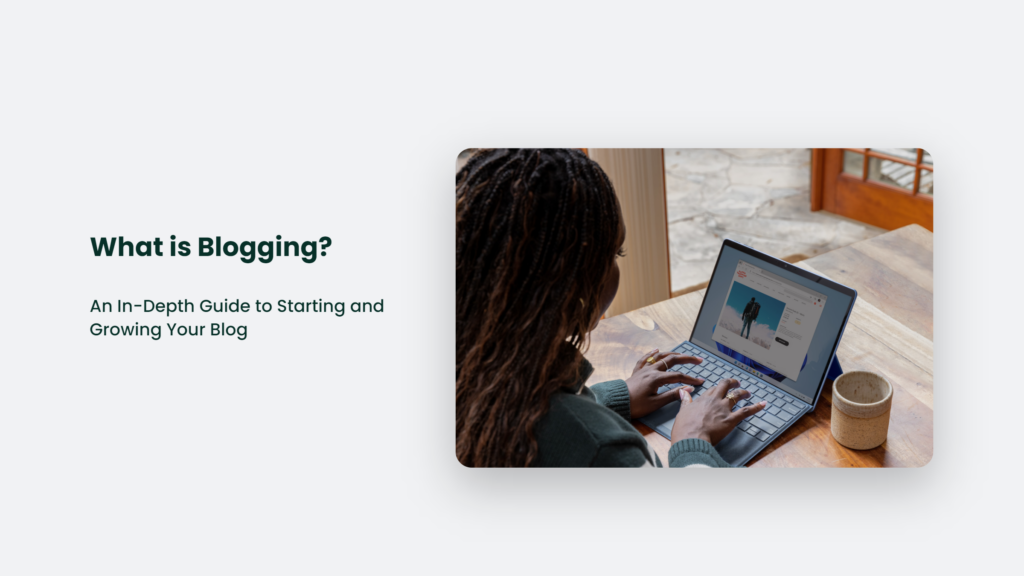Blogging is like riding a bike through the winding streets of life. At first, it’s a wobbly, uncertain endeavour. But as you gain experience, it becomes a smooth, enjoyable ride. So, what is blogging anyway?
Just like learning to ride a bike, blogging takes practice. But the rewards are well worth the effort.
Blogging allows you to share your unique perspective with a global audience. It’s a creative act of self-expression and connection.
This comprehensive guide will cover everything you need to launch and grow a successful blog. From choosing a niche to promoting your content, we’ve got you covered.
So buckle up your helmet, and let’s get rolling on the ultimate blogging adventure!

A Brief History of Blogs
The term “blog” originated in the late 1990s and derived from “weblog”. These early blogs were essentially online journals, allowing users to log their thoughts and experiences on the web.
Over time, blogging evolved into something much more. Today, blogs are on every topic imaginable – from food to fashion, travel to technology.
Some key developments in the history of blogging include:
- 1999 – Blogger launches, allowing users to publish blogs without coding. It opened blogging to the masses.
- The mid-2000s – “Mommy bloggers” gained popularity, foreshadowing the rise of influencer marketing.
- 2006 – Twitter launches, introducing the concept of microblogging.
- 2008 – WordPress passes 50 million downloads on its way to becoming the world’s most popular blogging platform.
- 2010s – Video blogging gains traction, led by YouTube vloggers.
Clearly, blogging has come a long way since the early weblog days! Let’s look at what exactly blogging encompasses today.
What is Blogging?
At its core, blogging simply means creating and sharing content online. But in practice, it’s much more nuanced.
Here are some key characteristics that set blogging apart:
- Informal tone: Blogs often have a conversational style, like you’re talking to a friend.
- Regular publishing: Successful blogs are updated frequently, often daily or weekly.
- Personality-driven: On a blog, you share your unique voice and perspective.
- Multimedia content: Modern blogs incorporate photos, graphics, videos, and more.
- Topic focus: Most blogs zero in on a specific niche or area of expertise.
- Engagement: Bloggers interact with readers via comments and social shares.
- Accessibility: Blogs have an open, democratic nature compared to traditional media.
Blogging requires consistency, creativity, and a willingness to share your passions with the world. It’s an immensely fulfilling hobby or career.
Next, let’s explore the main types of blogs lighting up the web today.
The Many Flavors of Blogs
There are endless varieties of blogs out there. But most fall into a few major categories:
Personal Blogs
These are blogs covering one person’s life and interests. Posts may include updates on daily activities, photos, travel journals, and reflections on life.
Small Business Blogs
Entrepreneurs use blogs to market, share business knowledge, and establish their brand’s voice.
Corporate/Organizational Blogs
Companies publish blogs to engage customers, promote thought leadership, and humanize the brand.
Topic/Niche Blogs
Blogs focused on a specific topic like food, politics, or movies are popular. Niche blogs attract engaged readers.
Video Blogs
YouTube channels, Twitch streams, and other video content fall under the umbrella of vlogging.
This list just scratches the surface but covers some of the most common blog types. You’ll likely incorporate elements of several as you grow your blog.
Now, let’s get into the nitty-gritty of how to start your blog.
How to Start a Blog in 5 Simple Steps
Starting a blog is easier today than ever before. You can get up and running in less than an hour with a few clicks.
Follow these five steps to launch your own blog:
Choose Your Niche
Select a topic that you’re passionate about and knowledgeable about. Popular niches include travel, food, business, tech, and more.
Secure Your Domain
Choose a domain name for your blog that’s short and memorable. For example, Blogger provides yourname.blogspot.com.
Design Your Site
Select a theme that reflects your brand and customize elements like fonts, colours, and page layout.
Write Your First Post
Introduce yourself and your blog’s focus. Embed images and style text to make it visually engaging.
And that’s it – you’ve officially launched your blog! Now, the fun part begins…writing and promoting enticing content.
Crafting Compelling Blog Posts
Consistently publishing excellent content is critical to building a loyal audience. Here are some tips for creating irresistible blog posts:
- Establish your voice. Write like you speak to form an authentic connection with readers.
- Add visuals. Break up text with relevant photos, infographics, YouTube videos and more.
- Structure content with headings, lists, and spacing to improve readability.
- Optimize for SEO. Include targeted keywords so your content can be found via search engines.
- Link to resources. Cite sources and link to related content to provide value.
- Promote shares. Include social sharing buttons so readers can easily distribute your content.
Blogging takes consistency and creativity. To generate endless ideas, stay curious about your niche and engage with your community.
Now, let’s explore how to grow your readership.
Promoting Your Blog: Getting Readers
You can have the most brilliant blog in the world, but it doesn’t matter if no one reads it. Promotion is crucial.
Here are some effective tactics for getting more blog traffic:
- Leverage social media. Share your posts in relevant Facebook Groups, subreddits, and forums.
- Run giveaways/contests. Offer prizes to incentivize shares and email signups.
- Guest post for other blogs in your niche to gain new readers.
- Optimize SEO through keywords, meta descriptions, alt text, and backlinks.
- Publish consistently. Google rewards frequently updated blogs with more rankings.
- Analyze metrics like pageviews and bounce rate. Adjust strategies accordingly.
- Build an email list. Collect emails with a signup form to share posts and engage subscribers.
- Collaborate with influencers. Partner with relevant bloggers and experts for cross-promotion.
With persistence and creativity in promotion, your blog can attract a thriving community around your niche.
Making Money Blogging: Monetization Tips
Once you’ve built an engaged following, you can start monetizing your blog by incorporating income streams.
Popular ways bloggers make money include:
- Affiliate marketing: Earn commissions promoting relevant products.
- Sponsored posts: Get paid by brands to review products or create branded content.
- Sell online courses: Create premium educational content and sell access.
- Freelance services: Offer your services like writing, design, or consulting.
- Sell merchandise: Design t-shirts, mugs, and other goods with your brand.
- Sell digital products: Provide downloadable guides, ebooks, and tools.
- Display ads: Join an ad network like Google AdSense to show ads.
With creativity and persistence, you can build a profitable blogging business by providing value to readers.
Frequently Asked Questions:
How often should you blog?
Posting 1-2 times per week is ideal for growing your blog. Consistency is key so readers know when to expect new content.
How long should blog posts be?
Aim for at least 300 words to provide enough value, but 1,000+ words is best for SEO. Mix up short posts with in-depth content.
Why You Should Start Blogging Today
Blogging provides endless rewards, both personal and professional. That’s why over 500 million blogs are active today.
Here are just some of the many benefits of blogging:
- Express your creativity through writing, photography, and design.
- Establish expertise in your niche, positioning yourself as an industry thought leader.
- Build community by connecting with readers who share your passions.
- Make extra income through advertising, affiliate marketing, freelancing services, and more.
- Be your own boss by working for yourself on your own blog.
- Gain new skills in content creation, marketing, SEO, social media, and more.
- Work from anywhere with just your laptop and WiFi connection.
Blogging lets you share your knowledge with the world on your own terms. It’s challenging yet immensely fulfilling.
If you feel that itch to start blogging, go for it! You can build a thriving blog and community around your passions with focus and persistence.
Just take it one pedal stroke at a time. Before you know it, you’ll be cruising smoothly through the blogosphere.
Now, get out there and start blogging!




